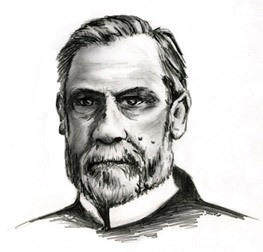A trained scientist, chemist and physicist, Louis Pasteur, dedicated his life to research, becoming a pioneer in microbiology.
But who was this man who identified the principle of fermentation and invented the rabies vaccine?
From his birth in 1822 until he presented his theses in 1847, his childhood was characterised by a taste for learning.
Louis Pasteur was born on 27 December 1822 in Dole, in the Jura, the son of a tanner, Jean-Joseph Pasteur and of Jeanne-Etienne Roqui. He spent his childhood in Dole with his parents, brother and three sisters, then Marnos and Arbois, where he did most of his shooling. In 1839, he enrolled at the collège royal de Franche-Comté in Besançon before his admission to the Lycée Saint-Louis in Paris. After having obtained his baccalauréat in literature and mathematical science, in 1843, he enrolled at Ecole Normale where he studied chemistry, physics and crystallography (the study of crystalline substances on the atomic scale).
He completed his studies in 1847 , presenting theses in physics to the faculty of science in Paris. His research work had only just started.
From that point on, his professional appointments and discoveries successively followed on from each other. Take a look at this surprising career.
He was appointed professor in Dijon then in Strasbourg from 1848 to 1853. During this period he started to become interested in fermentation. On 29 May 1849, he married Marie Laurent, the daughter of the head of the faculty of Strasbourg. She bore him five children. In 1854, he became the professor of chemistry and dean of the faculty of science of Lille. For three years, he worked on lactic fermentation until he presented his dissertation in 1857 .
He was then appointed administrator in charge of the studies division of Ecole normale supérieure, a position he held for ten years. In the meantime, he was elected to the Science Academy in the mineralogy section. When he resigned from his position of administrator in 1867, he received a chair at the Sorbonne and was appointed director of a physiological chemistry laboratory at Ecole normale supérieur. He was elected member of the Academy of Medicine in 1873. Two years later, by an Act dated 3 August 1875, the National Assembly granted him a pension for services rendered, allowing him to spend even more time on research.
He won international acclaim in 1885 with the discovery of the anti-rabies vaccine . The Institut Pasteur, founded in 1888, was set up to fight the rabies virus. This find marked the highlight of a series of discoveries that he developed while taking his inspiration from the work of his peers.
The discovery of the anti-rabies vaccine was just the tip of the iceberg. Zoom on his monumental work.
As from 1848, his work on molecular asymmetry had a major influence on the development of contemporary chemistry, in particular with the appearance of stereochemistry, which focused on the spatial layout of atoms within molecules. He was also known for his
publications, between 1857 and 1867, on his fermentation studies . Louis Pasteur discovered that certain organisms, including yeasts, were able to live in the absence of air. He called them
anaerobic organisms.
In 1866, his work on wine saw the appearance of pasteurisation, a technique consisting in heating a liquid before cooling it suddenly, with the aim of killing germs. His work on micro-organisms was used to develop antisepsis and asepsis. Between 1865 and 1869, he studied silkworm diseases and managed to eliminate pebrine which prevents larvae from rolling their silk fibres to make cocoons. Besides the anti-rabies vaccine, he also developed a vaccine against cholera in hens, against anthrax and against diamond skin disease in pigs.
Louis died on 28 September 1895 at Marnes-la-Coquette, in Seine-et-Oise. His name will not be forgotten. He left behind him a mass of research work that opened the way for several medical and technical innovations .
 A trained scientist, chemist and physicist, Louis Pasteur, dedicated his life to research, becoming a pioneer in microbiology.
A trained scientist, chemist and physicist, Louis Pasteur, dedicated his life to research, becoming a pioneer in microbiology. A trained scientist, chemist and physicist, Louis Pasteur, dedicated his life to research, becoming a pioneer in microbiology.
A trained scientist, chemist and physicist, Louis Pasteur, dedicated his life to research, becoming a pioneer in microbiology.